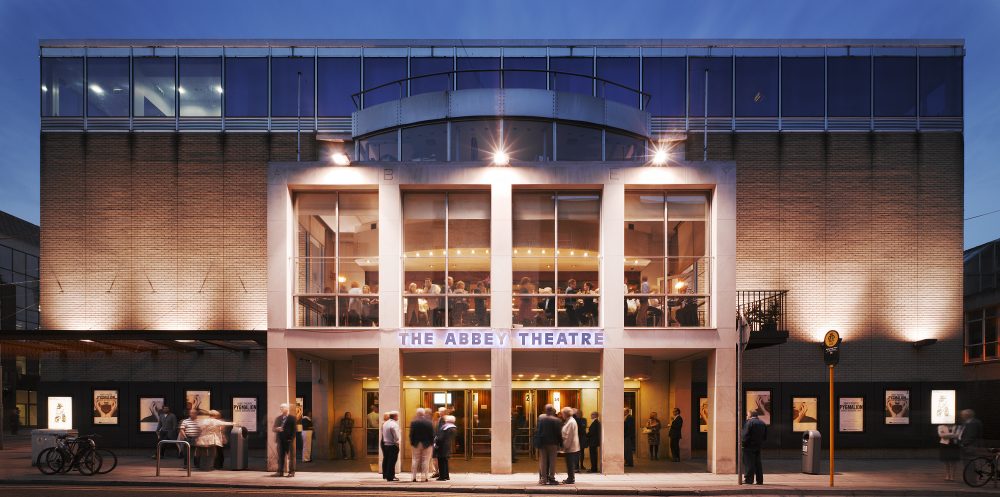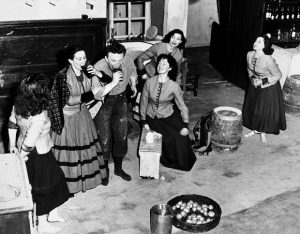Outrage and Irish Audiences’ Call for Ostensible Nationalism
Thanks to its dedication to representing Irish authors and voices, the Abbey has a history of provocative theater and outspoken audiences. The following two works elicited outrage upon their openings but were later considered cornerstones of the Irish Literary Renaissance.
The Playboy of the Western World, John Millington Synge, 1907
Playboy tells the story of a young Irish man, Christy, who has killed his father and brags about it to a group of men and women at a pub. His actions gain him admiration and attention from the local crowd and from the pub owner’s daughter, Pegeen, in particular. She and the Christy begin to fall in love and become engaged. However, it is revealed that the man’s father has not actually been killed. The locals learn of this and turn on Christy as he attempts to kill his father a second time. Pegeen rejects him and the man leaves in shame with his father as Pegeen laments her situation. (Gradesaver)
An image of The Playboy of the Western World, which caused riots upon its opening at the Abbey.¹
This play, written by Synge in a style meant to copy the bawdy language and approach of the Irish peasant class, caused a series of riots in which audience members shouted down actors in a conglomeration of hisses, boos, and calls for the murder of the author. So intense and unrelenting was the protest that the actors transitioned into miming the actions of the play in dumbshow. (New Yorker)
The Abbey Responds to the Response.²
Synge’s work, a poetic take on the Irish language, was taken as an attack on the character of the Irish people. The play, and by extension, the Abbey itself, were deemed not nationalist enough. Playboy appeared to critique the morality of Irish women in particular thanks to the single line, “a drift of females standing in their shifts.” A shift is a female undergarment, and the line referencing such was extremely offensive to audiences. In fact, in a note written to Yeats, Lady Gregory claims that the riots began the moment that word was used. Yeats declared the piece genius, and eventually, the riots petered out.
The Plough and the Stars, Sean O’Casey, 1926
The Plough and the Stars, by Sean O’Casey, is the story of Dubliners before and during the Easter Rising of 1916. Centered around Nora and Jack Clitheroe, the play starts in November 1915. Jack is a member of the Irish Citizen Army and has been promoted to the role of Commandant. Nora tries to keep Jack from attending meetings and participating in the army, but he continues to do so. The next scene takes place in a pub. Nationalists come in and out, bearing The Plough and the Stars flag as well as the Irish tricolor. They are riled up and willing to die for their country. The second act opens on Monday of the Easter Rising. Bessie, a supporter of England, mocks the nationalists and reasserts her allegiance to the crown. The rebels are being decimated, and Nora begs Jack to leave the fight. He ignores her and she goes into labor, but her baby is stillborn. In the final scene, it’s revealed that Jack has been shot, Nora has lost her mind, a local girl has died of tuberculosis, Bessie is shot in the back, and the rebellion has resulted in the death of hundreds of Irish citizens. (ART)
A nationalist rebel holds the Irish Tricolor in the Abbey’s 2016 production of The Plough and the Stars, which happened during the centennial of the Easter Rising³
The Plough and the Stars, which is the third installment of O’ Casey’s Dublin trilogy, received a similar but less intense reception to that of Playboy. The Irish people resented its portrayal of a sympathetic British supporter, Bessie, and declared it not nationalist enough. Overall, the play reads as a critique on the uprising and thereby on the movement towards Home Rule itself. Yeats, in frustration once again with the one-minded Irish audience, chastized O’Casey’s critics for being unable to recognize genius in its time.
- Toibin, Colm. “The Censor in Each of Us.” The New Yorker. The New Yorker, 19 July 2014. Web. 25 Apr. 2017.
- Front. “Theatre Archives.” Abbey Theater- Amharclann Na Mainistreach. Abbey Theatre, 12 Nov. 2015. Web. 27 Apr. 2017
- “The Plough and the Stars 2016.” www.abbeytheatre.ie.The Abbey Theatre, 2016. Web. 27 Apr. 2017.



